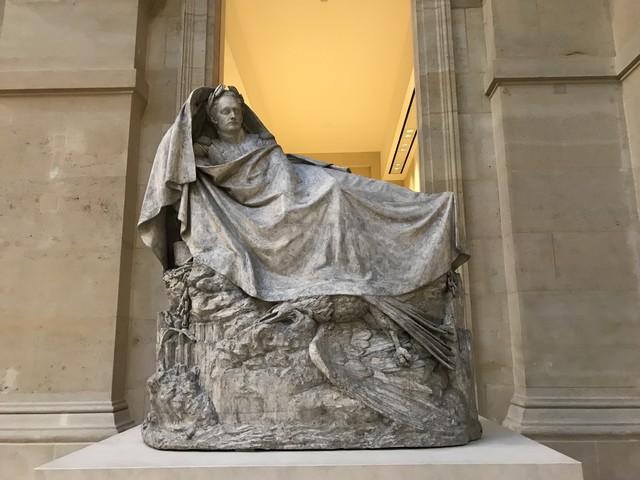The awakening of Napoleon

Carved by sculptor François Rude, this plaster model of a bronze work, it was commissioned in the early 1840s by Claude Noisot, former grenadier-foot and captain of the Vieille Garde. The soldier was a fervent follower of the Emperor, and had participated in the campaigns of Germany and Spain in 1809, Russia in 1812, Germany in 1813 and France in 1814. He had wished to accompany Napoleon I in exile in Elbe and, quite naturally, had supported his return to the Hundred Days. His military career ended with the defeat of Waterloo, but his devotion to the fallen ruler did not stop.
Far from works presenting the Emperor sick and tormented by the boredom of seclusion, the statue of Rude runs counter to the usual imagery of St Helena. Napoleon is not dying but dead - victorious over death, moreover - since he is resurrecting. This resonance with the resurrection of Lazarus in the New Testament and with the Last Judgment, however, is expressed in the absence of any Christian symbolism, with as its only frame an abstract concept not represented of immortality: Napoleon, eyes still closed by the supposedly eternal sleep here is the only magician thaumaturge of his return to life.
© Tourblink
"The Louvre will never be a convenient home, but I think of it as a palace of parade in which all the riches of art and science are to be gathered, such as statues, bronzes, paintings, libraries, archives, medals "... Napoleon I.
Set aside for the Restoration, Claude Noisot retired in 1835 and dedicated himself to the work of his life: the creation of a museum and a park dedicated to Napoleon I, with archives and relics of the First Empire. He set up this estate in Côte-d'Or, in the commune of Fixin, and built a building to house the museum, a real replica of the palace of I Mulini, in Elba. Noisot also had a hundred-storey staircase cut on his ground to recall the epic of the Hundred Days. The return of the Ashes in 1840 probably inspired the idea to Noisot to create a bronze statue of the Emperor to extend the symbolism of his Napoleonic sanctuary in Burgundy.
This sculpture also refers to Antiquity: the semi-recumbent position of Napoleon is reminiscent of Etruscan burial sarcophagi. The eagle, the imperial symbol here overthrown and half-covered by the shroud that Napoleon removes, allied to the presence of a chain that seems broken to allow the Emperor to recover, echo the myth of Prometheus. The titan was punished by Zeus for having given the sacred fire of Olympus to men and condemned to be chained to the Caucasus to be devoured the liver eternally by an eagle. Napoleon is here an anti-Prometheus who frees himself. No god, no prison can stop his immortal legend: the eagle, prisoner of St. Helena (advertisement of 1901), can now be reborn as the phoenix.